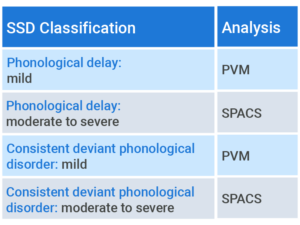Choosing the Right Speech Sound Disorder Analysis Style

In previous articles, we’ve looked at the differences between relational and independent analyses for speech sound disorders. We’ve also taken deep dives into the relational Place-Voice-Manner (PVM) analysis and the independent Specific Phonological Analysis of Child Speech (SPACS).
How do you decide which analysis is most appropriate for which specific speech sound disorder? And what role does the severity of the disorder play in this decision?
Comparing Analyses
Both the PVM analysis and the SPACS have their own advantages. They are both relatively easy and fast to complete, and they both include the use of a worksheet that provides a visual representation of the child’s errors, simplifying the speech-language pathologist’s task of identifying and organizing language differences.
But each analysis also has specific qualities that make it more or less appropriate for particular situations. For example, there are qualitative differences with regard to providing the best descriptive account of the child’s sound system as well as an explanatory account. This makes the SPACS only useful with those children who have multiple or unusual sound errors in which it is challenging for the therapist to determine the logic, or the “order within the disorder.”
Who Can Benefit Most from Which Analysis?
The table below summarizes the populations of children with SSD for whom each analysis is better suited. Dodd’s classification of SSD, which includes those types of SSD that are rule-governed and predictable, is used to specify the most appropriate analysis.

Putting It All Together
In summary, analysis of the most common types of SSD does not have to take three hours or longer to complete if we:
(1) understand the analysis frameworks of relational and independent analyses, and
(2) utilize worksheets developed for two different analyses to help us work as linguistic detectives to find the “order in the disorder.”
We can put the work back into the worksheets so we’re working smarter, not harder!
The end result will be a more thorough description and better understanding of a child’s sound system (their language), which ultimately leads to more effective intervention planning.
For additional insights and techniques you can apply today, explore the MedBridge catalog of over 800 speech pathology courses spanning specialties and settings. Motivate clients and advance your career with expert-led online SLP CEU courses featuring interactive demonstrations that include real patients and up-to-date, evidence-based strategies.
- Dodd, B. (2005). Differential Diagnosis and Treatment of Children with Speech Disorder. London: Whurr.
- Skahan, S., Watson, M., & Lof, G. (2007). Speech-language pathologists’ assessment practices for children with suspected speech sound disorders; results of a national survey. American Journal of Speech Language Pathology, 16: 246-259.
- Williams, A. L. (2001). Phonological assessment of child speech. In D. M. Ruscello (Ed.), Tests and Measurements in Speech-Language Pathology (pp. 31–76). Woburn, MA: Butterworth-Heinemann.
- Williams, A. L. (2005). Assessment, target selection, and intervention: dynamic interactions within a systemic perspective. Topics in Language Disorders, 25(3): 231-242.
- Williams, A. L. (2006). A systemic perspective for assessment and intervention: a case study. International Journal of Speech-Language Pathology, 8: 245-256.
- Williams, A. L. (2015). Assessment and intervention from a systemic perspective. In C. Bowen (2nd edition), Children's Speech Sound Disorders (pp. 199-203). Oxford: Wiley-Blackwell.









